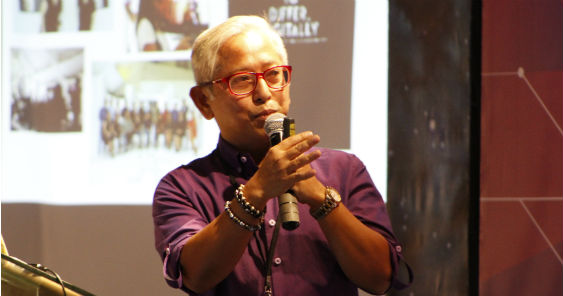By Nicai de Guzman
In the De La Salle College of Saint Benilde (DLS-CSB) rises a new center for campus art. As one of the 17 schools in the DLSU system, with 14,000 students, 50 faculty personnel, 3 campuses and 2 high rises, the time is ripe for students of arts and design to appreciate galleries in a new light. This is according to Architect Gerry Torres, the Director of the Center for Campus Art (CCA) in DLS-CSB.
During his talk in the adobo Design Series 2018 held in The Mind Museum on March 22, Arch. Torres shared how parts of the campus are turned into art spaces and how students of different disciplines are asked to participate and cooperate with one another.
It started with a vision
In DLS-CSB, there are 13 degree programs focused on design and arts. There are about 6,000 students enrolled in courses such as Architecture, Industrial Design, Fashion Design, Animation, Digital Film, Multimedia Arts, Theater Arts, Music Production, and more.
These art students are often asked to visit museums as part of their coursework, according to Arch. Torres.
“We had to drag our students to galleries and museums so I realized that one of the objectives that we have is for the students to appreciate galleries and museums. If we can’t bring them to the gallery, we bring the gallery to them,” Torres said.

Thus began his challenge to convert spaces to galleries and have a constant stream of shows every year. For starters, he fought for a 150 square meter space located near the cafeteria because of its good location and potential for foot traffic. The space had walls that can be reconfigured depending what kind of show they needed.
“It is in this gallery where we have the major shows and so far we’ve had 12 major shows. It’s amazing what you can do with 15 pieces of walls and 150 square meters,” he said.
So far, since the inception of the Center for Campus Art in October 2015, they’ve had 14 galleries since with about four major shows every year.
“The vision of the Center for Campus Art is for Benilde to become the biggest museum in terms of floor area. We hope to be able to install as many galleries as we can,” Torres said.
International shows and collaboration
The CCA’s first show came from the Spanish embassy about 40 years of Spanish fashion. It was packaged show going around the world so the CCA didn’t have to do much in terms of preparation. However, instead of being just a venue for a show, they wanted the students to react to the show and be connected to the concept of the exhibit. For this, they asked Architecture students to design pillars inspired by a Spanish fashion designer featured in the exhibit.
“We thought that by being cross disciplinary about the project, it can widen the understanding of their field,” Torres said.
Another show came from the French Embassy about architecture and durability. Students from Fashion Design were asked to create versions of the building in dresses, the reverse of the Spanish show. On the other hand, Architecture students created proposals for pavilions to be exhibited in the World’s Fair in 2025, with each pavilion representing an ASEAN country. The caveat is that the community around Pasig River will be able to use the pavilion once the World Fair has ended.
The next show was from the Danish Embassy about the Copanhagen Solution and sustainable designs. Torres explained that the exhibit was basically a series of large scale photos of what they’ve done in Denmark how they made urban life better.
This time, the students were tasked to create 3D exhibits to create solutions for urban problems of Manila like cleaning up esteros and finding a way to get rid of pests and make it greener, Torres explained.
“The show became a conversation of two cities – Copanhagen and Manila,” he said.
With these cross-disciplinary efforts and a chance to showcase their talents alongside international exhibits, Torres hopes that campus art will inspire students and let them feel pride in what they do. This should be able to manifest in their process and the way they exhibit their works properly.
“We also want to explain ourselves to visitors. I always tell them, you should be able to explain your work to a layman, at the least be able to explain what the exhibit is all about,” he said.
Torres added that the act of simply labeling their works properly is sign of work ethic.
“Commitment is also equals hard work. I don’t think hard work will ever go out of style,” Torres added.
The classroom is everywhere
The CCA makes sure the students can participate in their shows. They had one where half the gallery is where the stuff from Sydney and Thailand were exhibited and the other half was converted to an actual studio to recreate a print making gallery.
To date, the CCA has set up galleries in the cafeteria, in the Admissions Office, the Registrar’s Office, and in corners of buildings. They also make use of the building’s wide corridors. The natural light made it easy to set up an exhibit, according to Torres.

“We believe that every space in the school is a potential learning space and that the learning doesn’t just end in the classroom,” Torres reiterated.
This learning does not simply refer to the technical aspects of art, design, or galleries. The exhibits also teaches students about social realities and the world outside their school.
For example, an exhibit called To Differ Digitally, were initially aimed to create works that are fully digital. The gallery became a classroom because they were able to introduce new technologies such as augmented reality. Aside from learning about new gadgets, the show also showed the gruesome reality of extra judicial killings.
Another exhibit called Naichayu were an opportunity for students to learn the cultural meaning of tattoos. A collaboration with a differently-abled artist called Vico Cham opened the students’ minds about people’s capabilities.
Most recently, an installation called “Stations as a Nation” featured the responses of the students to what’s happening in the country. It’s a cross between Stations of the Cross and State of the nation so there were 14 installations throughout the building.
With the classroom being everywhere, Torres also said that inspiration can come from everywhere.
“A sense of curiosity will be very helpful in the creative industry – not just in your field but in other disciplines as well. Inspiration comes from everywhere and if you have a sense of openness to learn from many fields, that will help you in your chosen career. To be constantly curious is a great advantage.”










